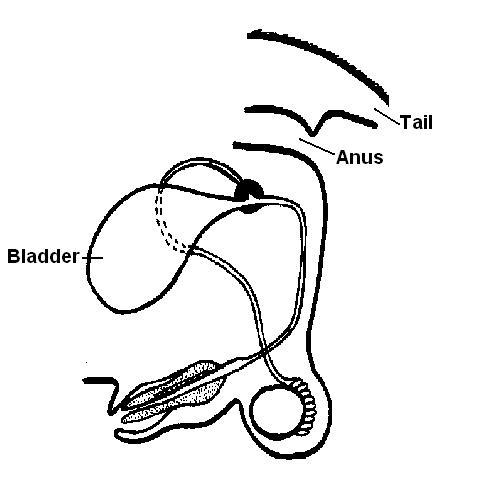The Reproductive System Test Yourself
From WikiEducator
1. Add the following labels to the diagram of the male reproductive organs below.
- testis | epididymis | vas deferens | urethra | penis | scrotal sac | prostate gland
2. Match the following descriptions with the choices given in the list below.
- accessory glands | vas deferens or sperm duct | penis | scrotum | fallopian tube | testes | urethra | vagina | uterus | ovary | vulva
- a) Organ that delivers semen to the female vagina
- b) Where the sperm are produced
- c) Passage for sperm from the epididymis to the urethra
- d) Carries both sperm and urine down the penis
- e) Glands that produce secretions that make up most of the semen
- f) Bag of skin surrounding the testes
- g) Where the foetus develops
- h) This receives the penis during copulation
- i) Where fertilisation usually occurs
- j) Ova travel along this tube to reach the uterus
- k) Where the ova are produced
- l) The external opening of the vagina
3. Which hormone is described in each statement below?
- a) This hormone stimulates the growth of the follicles in the ovary
- b) This hormone converts the empty follicle into the corpus luteum and stimulates it to produce progesterone
- c) This hormone is produced by the cells of the follicle
- d) This hormone is produced by the corpus luteum
- e) This hormone causes the mammary glands to develop
- f) This hormone prepares the lining of the uterus to receive a fertilised ovum
4. State whether the following statements are true or false. If false write in the correct answer.
- a) Fertilisation of the egg occurs in the uterus
- b) The fertilised egg cell contains half the normal number of chromosomes
- c) The morula is a hollow ball of cells
- d) The mixing of the blood of the mother and foetus allows nutrients and oxygen to transfer easily to the foetus
- e) The morula implants in the wall of the uterus
- f) The placenta is the organ that supplies the foetus with oxygen and nutrients
- g) Colostrum is the first milk
- h) Young animals often have to be given calcium supplements because milk contains very little calcium
